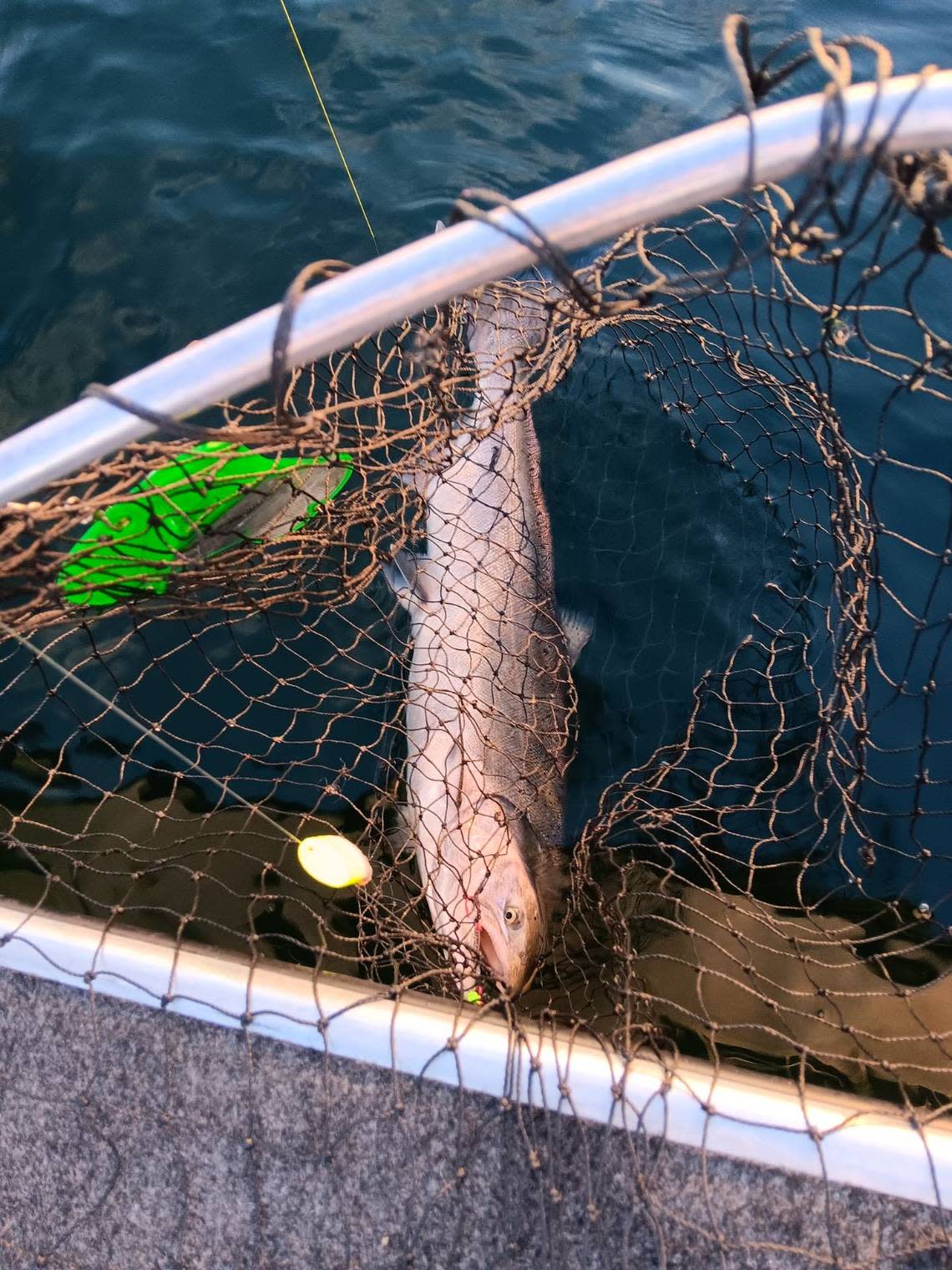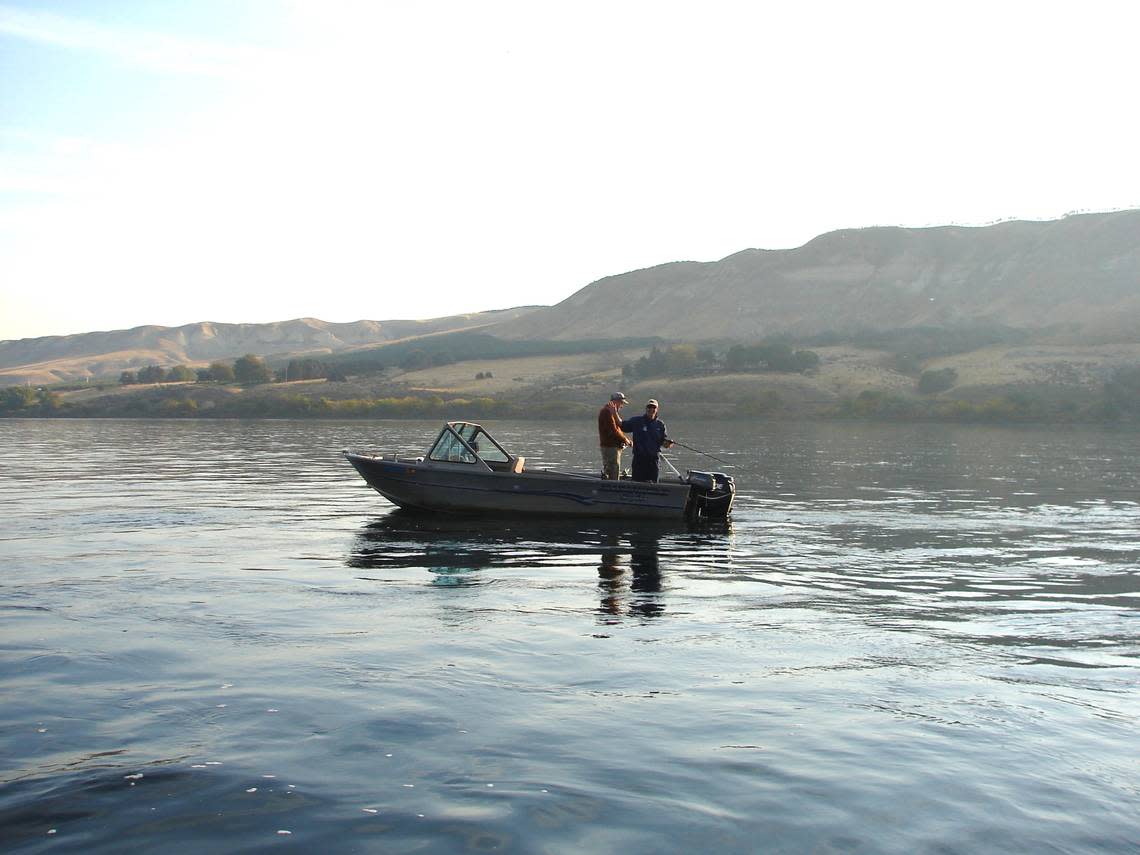Outdoors | Gear up for Hanford Reach salmon fishing. Tips on techniques, gear for each spot
The long, wet tongue of our corgi pup greets me when I roll over to look at the bedside clock. A lawn heavy with morning dew needs mowing and the house trim begs for a fresh coat of paint, but salmon fishing is on my mind.
I check my cell phone for messages. An early morning text begins with. “Caught a 19# and a 10#” by 815.” Another message comes in an hour later with, “One and done.” Other messages roll in, including ones with a photo of a salmon in a net and a batch of red-meat filets. I look out the window at cirrus clouds that hint of a calm day on the water.
Next up on my list is a morning walk with the pup so she can do her “natures.” After we return, I get a cup of coffee and peer at the computer screen to examine the 7-day fish count at Columbia River dams. How many fall Chinook salmon swam over McNary Dam and up the Snake River versus entered the Hanford Reach? I wonder if flows favor salmon staging in the lower Reach or if they will blitz to upstream spawning grounds.
My introduction to fall salmon fishing occurred downstream of Wanapum Dam where we backtrolled wrapped Kwikfish behind a lead ball at the railroad bridge and Crab Creek hole.
Only later did I find out late-run salmon in good condition could be caught in the Hanford Reach without trailering my boat 50 miles.

Each Hanford Reach location, from the I-82 bridge and upstream to Vernita may require a change in technique and gear. For that reason, the salmon fishing arsenal on my boat now consists of multiple gear bags, half a dozen rods, twenty pounds of lead balls (1- to 10-ounce) and a bait cooler that holds prawns, salmon roe, tuna, sardines, and bottles of scent. Attractors include various sizes and colors of dodgers, pro-troll flashers, and in-line flashers.
That’s the half of it. Ready for action in stow-away lure boxes are over one hundred Wiggle Warts (wee, regular, magnum), close to fifty Kwikfish (k-13 to k-16), over two dozen Super Baits (original and cut plug), and more spinners (Vibrax and Mepps, #3 to #6) than I care to count.
The amount of fishing gear an angler might accumulate can border on ridiculous. I am reminded of fly fishers whose collection of trout flies number in the thousands and of a bass angler who kept the back of his long-bed pickup truck filled with spare rods and reels. What makes my unused volume of gear pathetic is I always tie on the last plug that caught a salmon.
Stories of lucky plugs could fill the pages of a James Michener-size novel. One friend tells of acquiring 18 notches on a favorite Kwikfish. Another uses a sharpie to mark Wiggle Warts that hooked a salmon with “fc” (short for fish catcher). My dearly departed brother, Daran, broke off my most revered salmon plug, a Double Trouble k-16 Kwikfish with over a dozen salmon to its name, when he thumbed down the drag on a derby-size Chinook salmon.
“Why did you do that? I asked. “The drag was set perfect.”
“It was taking out line,” he replied with chagrin.
Unlike fly fishing for trout, salmon fishing is not about “matching the hatch.” Salmon don’t actively feed once they enter freshwater, which makes it difficult to figure out exactly where and when to fish, and what method will lead to success.
So why the one-salmon daily limit this year? Early prediction for returns of upriver bright fall Chinook salmon to the Hanford Reach indicate a downward trend for natural origin (wild) fish. According to the WDFW, the typical run is comprised of 70% wild origin salmon, while this year they expect 35% wild and 65% hatchery fish. Reductions in angler harvest are needed to achieve the spawning escapement target of 31,100 wild adults.

If the reduced harvest of one fish per day holds, expect shorter guided trips and possibly more anglers bragging that they caught their limit.
Following obligatory morning walks with an energetic corgi pup, my first two trips on the Reach failed to yield a take down. No big surprise. Every serious salmon angler knows the best bite occurs when salmon move at first light. Regardless, time on the water led to good practice picking weeds off gear.
I can’t complain (yet). It was a decent sockeye season, albeit truncated by warm water temperature. The freezer is loaded with smallmouth bass and walleye filets and stream trout rose to the fly all summer long. Salmon fishing can only get better as water temperature drops and more fish enter the Reach.
Meanwhile, my cell phone buzzes with group texts that remind what I am missing. Until I get on the water to test the noon bite again, I will live vicariously through the adventures of angling pals. It won’t be the first time I don’t catch a fall-run Chinook salmon until the last week in September. But hey, who is counting?
Dennis Dauble has written five books about fish and fishing. He can be contacted at his website, DennisDaubleBooks.com.
